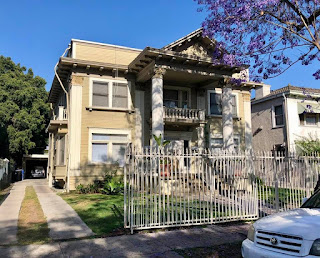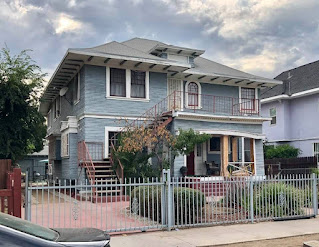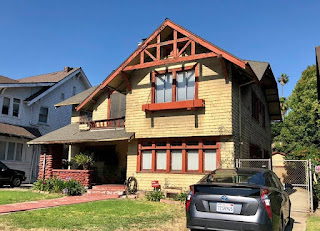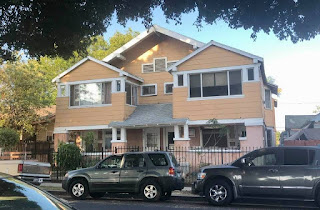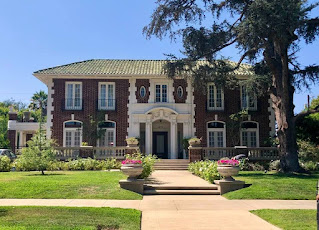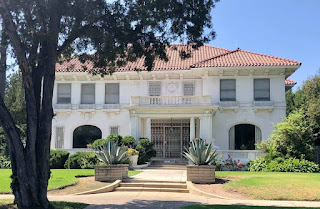West Adams is a historic neighborhood in the South Los Angeles region of Los Angeles, California. The area is known for its large number of historic buildings, structures and notable houses and mansions throughout Los Angeles. It is a youthful, densely populated area with a diverse population. The neighborhood has several public and private schools.
West Adams is one of the oldest neighborhoods in the city of Los Angeles, with most of its buildings erected between 1880 and 1925, including the William Andrews Clark Memorial Library. West Adams was developed by railroad magnate Henry E. Huntington and wealthy industrialist Hulett C. Merritt of Pasadena. It was once the wealthiest district in the city, with its Victorian mansions and sturdy Craftsman bungalows, and a home to Downtown businessmen and professors and academicians at USC. Several historic areas of West Adams, namely, Harvard Heights, Lafayette Square, Pico-Union, and West Adams Terrace, were designated as Historic Preservation Overlay Zones by the city of Los Angeles, in recognition of their outstanding architectural heritage. Menlo Avenue-West Twenty-ninth Street Historic District, North University Park Historic District, Twentieth Street Historic District, Van Buren Place Historic District and St. James Park Historic District, all with houses of architectural significance, are located in West Adams.
The development of the West Side, Beverly Hills and Hollywood, beginning in the 1910s, siphoned away much of West Adams' upper-class white population; upper-class blacks began to move in around this time, although the district was off limits to all but the very wealthiest African-Americans. One symbol of the area's emergence as a center of black wealth at this time is the landmark 1949 headquarters building of the Golden State Mutual Life Insurance Company, a late-period Moderne structure at Adams and Western designed by renowned black architect Paul Williams. It housed what was once one of the nation's largest black-owned insurers (currently, along with an adjacent new building, it is now a campus for a large non-profit). West Adams' transformation into an affluent black area was sped by the Supreme Court's 1948 invalidation of segregationist covenants on property ownership. The area was a favorite among black celebrities in the 1940s and 1950s; notable residents included Hattie McDaniel, Tim Moore, Eddie Anderson, Joe Louis, Sweet Daddy Grace, Little Richard, Lionel Hampton and Ray Charles.
Singer Ray Charles's business headquarters, including his RPM studio, is located at 2107 Washington Boulevard. The intersection of Washington Boulevard and Westmoreland Boulevard, at the studio, is named "Ray Charles Square" in his honor.
Starting in 1961, construction of the ten-lane Santa Monica Freeway (Interstate 10) began through West Adams' core, with the freeway routed east to west just north of Adams Boulevard. Its construction resulted in the taking by eminent domain, and demolition, of numerous West Adams homes. As in many other American cities during the heyday of Interstate Highway Act construction, interstate highway rights of way were disproportionately routed through predominantly less affluent communities.
Many of the neighborhoods, including West Adams, are experiencing a renaissance of sorts with their historic houses being restored to their previous elegance. The area is undergoing revitalization with young professionals, restaurants, new businesses moving into the area. Many professionals are being attracted to the area, due to the proximity of job hubs in Silicon Beach, Culver City, and El Segundo.
According to the "Mapping L.A." project of the Los Angeles Times, West Adams is flanked by Mid-City to the north—across the Santa Monica Freeway—Jefferson Park to the east, Baldwin Hills/Crenshaw to the south and Palms to the west. The neighborhood's street boundaries are the Santa Monica Freeway on the north, Crenshaw Boulevard on the east, Exposition and Jefferson Boulevards on the south and the Culver City line on the west (Ballona Creek and Fairfax Avenue).
West Adams is home to one of the largest collections of historic houses and small mansions west of the Mississippi River. The West Adams neighborhood was developed between 1880 and 1925 and contains many diverse architectural styles of the era, including the Queen Anne, Shingle, Gothic Revival, Transitional Arts and Crafts, American Craftsman/Ultimate Bungalow, Craftsman Bungalow, Colonial Revival, Renaissance Revival, Mediterranean Revival, Spanish Colonial Revival, Mission Revival, Egyptian Revival, Beaux-Arts and Neoclassical styles. West Adams boasts the only existing Greene and Greene house left in the entire city of Los Angeles.
More than 70 sites in West Adams have received recognition as a Los Angeles Historic-Cultural Monument, a California Historical Landmark, or listing on the National Register of Historic Places.
Below are some photos of an assortment of regular homes that I've taken of West Adams south of Adams, north of Jefferson between Normandie and Vermont. These homes are a mix of the good, the bag and the ugly.
Mary Cummins of Cummins Real Estate is a certified residential licensed appraiser in Los Angeles, California. Mary Cummins is licensed by the California Bureau of Real Estate appraisers and has over 35 years of experience.
- Mary Cummins LinkedIn
- Mary Cummins Meet up
- Cummins Real Estate on Facebook
- Mary Cummins Real Estate blog
- Cummins Real Estate on Google maps
- Mary Cummins of Animal Advocates
- Mary Cummins biography resume short
- Mary Cummins Real Estate Services
- Animal Advocates fan page at Facebook.com
- Mary Cummins
- Mary Cummins Animal Advocates on Flickr photos
- Mary Cummins Animal Advocates on Twitter.com
- Mary Cummins on MySpace.com
- Mary Cummins on YouTube.com videos
- Mary Cummins of Animal Advocates on Classmates
- Mary Cummins on VK



